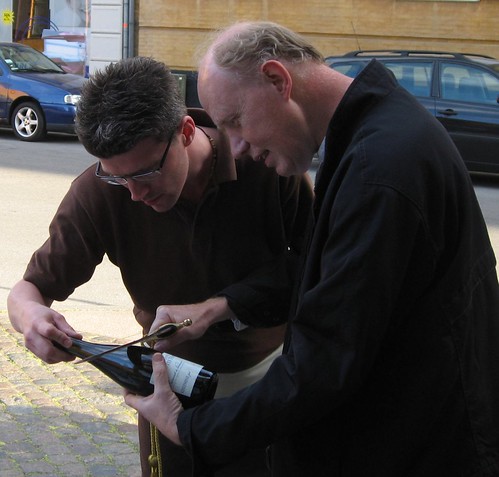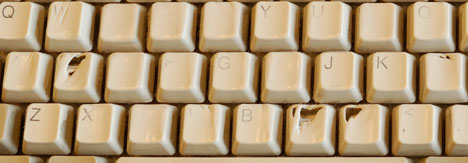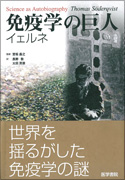Historians of contemporary biomedicine are well advised to listen when leading scientists and well-placed science administrators air their views on interesting trends in the field. When Francis Collins announced yesterday that he will step down as head of NIH’s National Human Genome Research Institute, he also said that he is planning to write a book on the regulatory and scientific issues involved in personalized medicine. Because, in Collins’s view, this is “a fundamental shift in medical care”. An excellent topic for a research project in contemporary history — but a damned difficult one for an exhibition.
Suggestive calls for papers to interesting seminars and conferences appear in the inbox almost daily. Usually I understand what these messages mean, but sometimes I’m in doubt. For example, I just received one for “Thinking and Making Connections: Cybernetic Heritage in the Social and Human Sciences and Beyond”, a conference to be held at Södertörn University College in Sweden, 10-11 November.
‘Cybernetic heritage’ — sounds good, but what is it? Didn’t find any info on the department’s website, then tried to google it (25 hits today, 26 tomorrow :-), but didn’t become wiser. Is it about the acquisition and preservation of robots in museums? Or the lingering-on of old cybernetic ideas in the social sciences and humanities? Both could be exciting — but maybe the organisers mean something entirely different?
Attila Chordash (Pimm) reminds us that we spend many hundreds of hours a year looking at desktop background images. Maybe they are among the most looked-at images in our lives. What are scientists’ preferred desktop background images? I know some people who choose awesome images from the Hubble telescope, while others stare at scary creatures from the bottom of the ocean. Pimm prefers this one:

from Bonnet et al., “A Mitochondria-K+ Channel Axis Is Suppressed in Cancer and Its Normalization Promotes Apoptosis and Inhibits Cancer Growth”, Cancer Cell 11 (1), 37-51, 2007 (Figure 1. A Reversible Metabolic-Electrical Remodeling in Cancer Contributes to Resistance to Apoptosis and Reveals Several Potential Therapeutic Target).
Well, it reminds me about the sad fact that the aesthetics of desktop images is so far a much under-researched area of visual culture studies 🙂
Yesterday, we had a whole-day meeting with our new advisory board, appointed by the Dean of the Faculty of Health Sciences for a three-year period. After a short resumé of our Annual Report for 2007 (which will be on-line soon) the ten Board members engaged in a very lively discussion about our work — from research and teaching to acquisitions and temporary exhibitions. Lots of constructive feedback! In the afternoon we proceeded with the future plans, some of which will later also be presented on this blog.
It’s pretty exhausting to be scrutinised for six hours by a group of ten highly qualified research scholars and museum directors. But it is also an extremely useful exercise. First, the production of a detailed annual report has given us a unique chance to pause for a moment and recapitulate our activities. Second, it’s great to hear a group of experienced people evaluate your work (especially when they are mainly positive :-). And third, the discussion around the table generated a lot of insights which we wouldn’t have been able to produce on our own. In fact, several members of the Board thought that, in the course of the day, the meeting developed from an evaluation event into a mutually inspiring seminar.
The aims of the Board are:
- to evaluate Medical Museion’s activities, i.e., research, teaching, collection management, acquisitions, exhibitions, and other public outreach initiatives, in the preceeding year
- to evaluate the present and possible future status of Medical Museion in relation to the long-term strategy for the University of Copenhagen and the development of similar institutions internationally
- to discuss Medical Museion’s vision for the forthcoming years and provide inspiration for long-term planning
- to advice the Director of Medical Museion with respect to the realisation of these plans.
- to advice the Dean of the Faculty of Health Sciences with respect to the overall future development of Medical Museion.
The members of the Board are: Gert Almind, Director of the Novo Nordisk Foundation (chair); Ken Arnold, Head of Public Programmes at the Wellcome Trust, London; Bodil Busk Laursen, Director of the Danish Museum of Art & Design, Copenhagen (vice-chair); Liselotte Højgaard, Head of the Department of Clinical Physiology and Nuclear Medicine & PET and Cyclotron Unit, Danish National Hospital, Copenhagen; Svante Lindqvist, Director of Nobel Museum, Stockholm; Sharon MacDonald, Professor at the Department of Social Anthropology, University of Manchester; Robert Martensen, Director of the Office of NIH History, National Institutes of Health, Bethesda, Md.; John Pickstone, Wellcome Research Professor at the Centre for History of Science, Technology and Medicine, University of Manchester; Thomas Schnalke, Director of Berliner Medizinhistorisches Museum der Charité, Berlin; and Cornelia Weber, General Manager of the Hermann von Helmholtz-Zentrum für Kulturtechnik, Humboldt Universität, Berlin.
And we were: Bente, Camilla, Søren, Ion and myself.

Ken Arnold is instructed in the art of sword-opening a Cremant bottle right before the Board dinner on Sunday 25 May.
The new Centre for Museums, Heritage & Material Culture at University College London is organising an afternoon workshop on Wednesday 25 June 2-5pm on the theme “Heritage and Wellbeing”. The purpose of this workshop is to bridge the relevant work of
academics in various disciplines, medical professionals, researchers, museum, library and archive workers, and arts curators by exploring common themes such as touch and object handling, ethnographies and institutions of care, arts in health, and the histories of hospitals and health. The key focus of the workshop is to define research themes and identify practice-led projects, in order to develop appropriate methodologies and to create a critical framework for assessing wellbeing in the context of heritage.
Attendence is free, but space is limited so advance registration is necessary — write to Sonjel Vreeland s.vreeland@ucl.ac.uk. Read more about the workshop here.
With a background in the history of 20th century life sciences, I didn’t know much about museums when I took this job. But I’m gradually learning the tricks of the trade and must admit that almost everything about museums is quite fascinating, especially acquisitioning becuse it’s so close to research.
I’m much more ignorant about the administrative and economic aspects. But there is one thing about the economics of museums that has caught my interest lately, namely the way museums are entangled in the experience economy.
For example, take the travelling exhibition “Gregor Mendel: Planting the Seeds of Genetics” which was developed in 2005-2006 by the Field Museum in Chicago and which opens today on its fourth and last tour stop at the Academy of Natural Sciences in Philadelphia. Judged from the website this is a small and fairly conventional exhibit—it includes original notes, correspondences and a few artifacts from Mendel’s scientific work in the Brno abbey, they have also included some genetic art works, and a few interactives (“Try your hand at comparing the DNA of a flamingo with those of other birds to see how they’re related”), and so forth. Nice, but apparently not earth-shattering.
But the economic side is fascinating: in addition to the usual in-house operation costs, the Academy pays for transportation and insurance (which can easily be 25.000 USD or more). And on top of this, they pay for renting the exhibition, in this case 85.000 USD for 3 months.
So what’s in it for the Field Museum? Well, this particular exhibition has only been booked by four other museums, which means that they only earn a total of 340.000 USD by shipping it around the US (after having shown it to their own Chicago audience, of course). This probably equals what it cost them to develop the show in the first place, so “Gregor Mendel” is presumably a break-even.
But some of Field Museum’s other exhibitions are blockbusters. The dinosaur show “A T. rex named Sue”, developed in 1999-2000, has been to about 50 museums around the world (in two parallell copies; see tour overview here). They don’t tell the cost of renting it on the website. But if a Mendel exhibit costs 85.000 USD, you can imagine the prize of a dino show. Probably this returns a total income around 5-10 mill. USD for the Field Museum, well above their costs for developing it in the first place.
The icing on this particular dino show experience economy cake is that McDonald’s (yes, the hamburgers!) “works closely with each venue to create and support a strong local campaign of advertising, marketing, in-store promotions, and media relations to drive museum attendance” (quote from here).
Admittedly, as a state-employed historian of science/medicine I’ve so far been quite naïve about the larger economic aspects of museums of our kind. Okay, it’s one thing to join forces with a global hamburger chain to sell tickets to plastic casts of 70 mill. yr old dinosaur skeletons in local natural history museums all over the globe; and it’s another thing to co-operate with a national anaesthesiological society to make 50 year old resuscitating balloons engaging to an international anaesthesiological congress, as we are doing right now (see upcoming post in a few days). Apparently two very different museum worlds. Yet, we operate, in principle, on the same experience economical market place.
Food for thought, although I’m not quite sure where this is heading. Perhaps someone can help me to develop these thoughts further?
I’ve earlier (“The presentation of self in everyday laboratory web life”) written about my fascination with the new ways in which biomedical researchers present themselves on their websites and blogs. The public face of bioscience and biotech is, for better or for worse, becoming increasingly egocentric and self-presentational. So I was intrigued when I read about the ESF funded exploratory workshop on Ego-documents which my friend Michael H. is attending right now:
Everywhere in Europe, scientific teams or scholars are working on egodocuments. Egodocuments are a specific kind of texts produced by ordinaries people from the end of the Middle Age including memoirs, autobiographies, diaries and other forms of private journals. These fascinating documents could be used in a great number of topics like the history of the self, the history of the family or the history of the European culture and some of these teams are even currently building extensive censuses of all egodocuments kept in archives or libraries. Participants will search the ways to coordinate these efforts at an European scale, to share experience about the use of these texts, to extend the censuses to all the European countries, and to develop common scientific approaches to these texts.
It would have been fun to attend! (Michael sometimes keeps interesting things to himself 🙂 Because the study of late medieval and early modern ego-documents could in fact teach us something about how to study 21st century ego-webpages. But it could also be a total flop, of course. More than ten years ago, I participated in a conference on the epistolary genre with presentations about all kinds of letter-writing, from Mesopotamian clay tablet letters via Roman correspondences to German Romantic epistles. My contribution about letter-writing among mid-20th century scientists was totally ignored, however – the mere fact that I spoke about letters between scientists turned my more authentic humanities colleagues (philologists and literary historians) off.
Such attitudes have certainly changed (the growing interest for the Society for Science, Literature and Arts is an indication of this). For example, a variety of poststructuralist approaches have informed humanistic studies of science. But the tradition of classical humanistic approaches could also be a rich source for understanding social and cultural phenomena in contemporary biomedicine. I mean, even classical philology could generate new and interesting analytical perspectives and research topics.
Some medical objects, like stethoscopes or mechanical hearts, are almost 100% ‘medical’. They are not made for other purposes, they are rarely used for other purposes, and they are almost always understood by others as ‘medical’ objects.
But what about this worn-out keyboard?

It was produced as a multipurpose keyboard, clones of it are used in a variety of professions and contexts — and few of us would think of any of these as ‘medical’ objects.
Yet, this particular keyboard was used by a medical transcriptionist, says Cory Doctorow who cites a colleague:
We have a medical transcriptionist on staff who has been using the same keyboard for the last 8.5 years. My co-worker replaced it yesterday, and when he first showed it to me I thought someone had taken a blowtorch to it! The most frequently used keys have been completely worn through, exposing the mechanism beneath. Zoom in and check out the indentation on the Backspace key! The keyboard still works fine, so there’s something to be said for durability. BTW, it’s a NMB Technologies model RT2358TW
Today’s Medgadget use the image to illustrate their celebration of the (US) National Medical Transcriptionist Week, designated in May 1985 by president Ronald Reagan, who said in a speech:
Record-keeping is a vital function in our society, and one of the most important records for every American is the medical record. That record, including reports prepared and edited by a medical transcriptionist from physician dictation, is the permanent history of a patient’s medical care.
I doubt a historian of contemporary medical history could have better summarised the role of medical transcriptionists in the health service sector.
And I doubt that any other object is better suited to function as an evocative object of the profession — crystallising the daily work conditions of hundreds of thousands, mainly women, transcriptionists.
(originally brought by boingboing)
A couple of weeks ago I received a package which, to my great joy and surprise, contained five copies of my biography of Niels K. Jerne (Science as Autobiograhy, Yale UP, 2003) in a Japanese translation. 
The rights were sold to the big Tokyo publisher Igaku Shoin already in 2004. But I never heard anything from them, and occasional inquiries never yielded anything but polite avoidance replies. So it is very pleasing to see it in print at last.
My knowledge of Japanese is less than rudimentary so I churned the title (免疫学の巨人イェルネ) through Google Translate and got another—but less joyful—surprise: ‘giants immunology jerne’! Could be a Google blunder, of course, but it doesn’t even remotely looks like anything like ‘autobiography’.
The Japanese title is a pretty far shot from (well, even the opposite of) the idea behind the original title. The thrust of the book is that Jerne’s theoretical work in immunology was a metaphorical projection of his understanding of himself. His science was literally his autobiography. Accordingly Science as Autobiography is a case-study of an auto/biographical approach to understanding the construction of scientific knowledge. My claim is that the inner life of the scientist constitutes an emotional and existential context for the production of scientific knowledge which is as important as the cultural or social contexts.
Most reviewers got this message right (like Fred Tauber in Bull. Hist. Med.). But, alas, it gets completely lost in the translation. The new title erroneously classifies the biography into one of these hagiographical works that I very consciously tried to stay away from. Maybe some immunologists believe Jerne was a ‘giant’, but I certainly didn’t portray him as such. It simply wasn’t the intention of the book. The summary on their website (in Google translation) isn’t better.
That said, it’s great that the book is now available for a wider Japanese readership. To Igaku Shoin’s credit, they have kept the whole note apparatus and the full bibliography, and all the illustrations are intact too. And it’s very nicely set and bound, and (as far as I can see 🙂 there are no typos.
What makes these everyday things—a food storage container, a measuring cup, a cake keeper, a beverage bottle, etc—potential contemporary medical museum objects?

Well, it turns out they all contain bisphenol A, 
In addition to being a very useful hard plastic ingredient, however, BPA is also a biologically active molecule, having the spooky effect of being an estrogen receptor antagonist; in other words it disturbs the endocrine system. The effects of endocrine disruptors are debated. But most pundits seem to support a better-safe-than-sorry policy (see, for example, this interesting interview on the Stanford School of Medicine website with emeritus endocrinologist David Feldman, who warned about the possible effects in the 1990s).
The display of a collection of such objects could be a nice everyday-life appetizer to a future exhibition about the many dangerous substances—radioactive isotopes, toxic chemicals, nanoparticles and so forth—that affect public health. The problem with such exhibitions is precisely the invisibility of many environmental hazards. The use of objects like Rubbermaid beverage bottles and Tupperware microwave canisters could be one way to mentally visualize (and materialize) the problem. (Tupperware say they’ve abolished BPA in their baby bottles and other products, but that they keep it in their microwave line.)
(credits: thanks to Medgadget for Feldman interview link and object image—which they in turn got from Rubbermaid—and to Wikipedia for molecule image)
